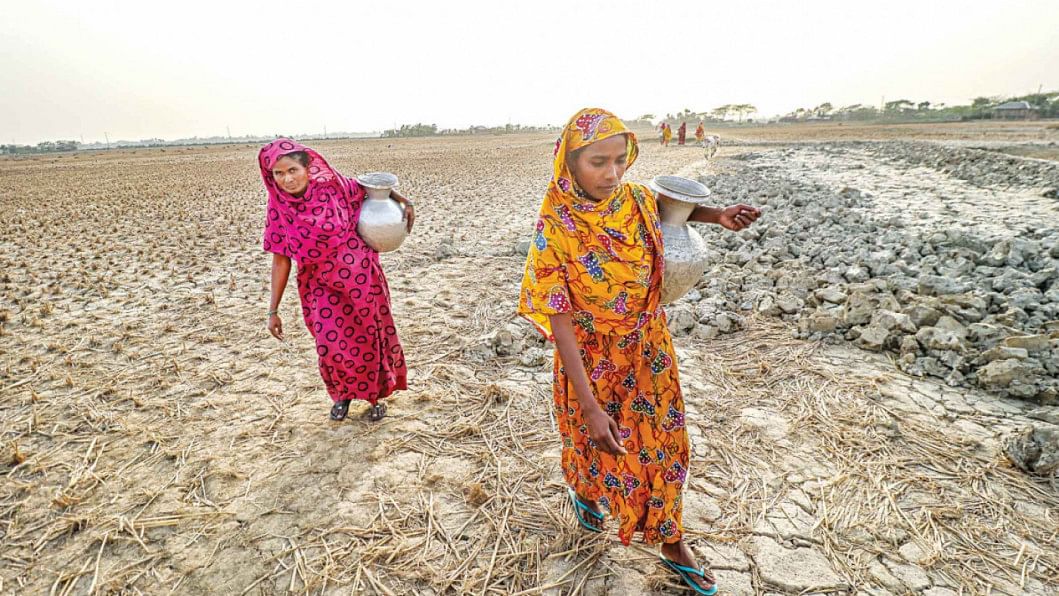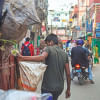For safe consumption, rainwater needs proper harvesting

For 13 years, a schoolteacher from Gabura in Shyamnagar, Satkhira, had been collecting rainwater that seeps through her asbestos roof for drinking. Now, she has been diagnosed with lung cancer due to prolonged exposure to asbestos.
Lack of safe drinking water is an acute problem in the coastal regions of Bangladesh, which are highly affected by salinity intrusion. Generally, people living in climate-change-affected areas practice the traditional technique of harvesting rainwater in earthen pots, blue barrels, polythene bags or a container. However, although rain is considered to be one of the safest sources of drinking water, in order to ensure that it is indeed safe, the rainwater harvesting system (RHS) has to be maintained and practiced properly. In the case of these coastal regions, the water stored falls directly off their roofs, without any filtration.
Despite the practice of capturing rainwater in coastal districts, its limited scale still causes a shortage of drinking water supply in the drier seasons. As a consequence, people are bound to drink water from nearby water sources that are severely affected by salinity intrusion. Hence, they suffer from various water-contaminated ailments.
Along with salinity intrusion, climate change is to blame for the summer heatwaves, which is also hampering water security. This is having a devastating effect on coastal communities who do not have access to adequate water supplies. This poses a dire and growing threat to the health of people, mainly women and children.
The coastal area of Bangladesh is privileged by the huge quantity of rainfall during monsoon. In Mongla, rainfall generally varies between 170mm to 429mm per month, which usually lasts from May to October, with occasional rainfall in November. However, in recent times, there have been changes in the rainfall pattern, which shows heavy sudden rainfalls have increased, leading to fewer, more intense rainfall events in many areas of Bangladesh. Extreme and unpredictable weather is having a serious impact on the social and economic conditions of coastal communities, who end up paying the most for their water.
Nur Jahan Begum (52) lives in Bagerhat's Mongla upazila, and her monthly family income is Tk 8,000. The cost of drinking water she bears is 3.5 percent of her daily income. She reckons an even larger amount of money goes into buying water during the dry seasons.
Access to clean water is not only fundamental to achieving Sustainable Development Goal 6 (SDG 6), but is also a critical adaptation strategy for communities in coping with the effects of climate change. In this context, rainwater harvesting has always been an efficient and vital alternate solution to address the problem. However, there is a need to generate knowledge on the proper management of rainwater to ensure sustainability of the environment, and enhance the social and economic growth and development of Bangladesh. Rainwater harvesting is feasible, practical and environmentally vital for people, profit and the planet. Working with the climate-change-affected vulnerable communities in Mongla, a rainwater harvesting system (RHS) has been developed by Brac's Climate Change Programme (CCP) to support low-income households in tackling the safe water crisis. The technology includes a concrete base, a polyplastic tank with a low-cost cloth or a device – used for filtration – and pipe fittings that are attached to the tank's roof. The capacity of the water tank is 2,000 litres for individual households, which is sufficient to drink during the summer and onwards.
However, the water tank requires regular maintenance, and simple but effective processes need to be followed to prevent contamination and preserve the quality of water. When it rains, it is advisable to turn the tap on and keep it on for the first 5-10 minutes to dispose of the polluted first flush of the rainwater. During the rainy season, the water can be stored and used, but just before the arrival of drier seasons, the tank needs to be filled with rainwater to drink in the next six months.
In the coastal communities, the sufferings of people when collecting drinking water for their families are inexplicable. The water available from the pond is salty and polluted, so people have to travel miles to find a safe source of drinking water. Even the water stored for household use can get contaminated. In addition to all this, intensified use of groundwater in domestic and agricultural purposes further exacerbates the current gap between water sources and demand for safe water supply.
From ancient to modern times, harvesting rainwater has always been a backup plan to meet water needs. The recent safe water crisis in the coastal communities is teaching us to adopt strategies that could scale up and promote innovative technologies and policies as the most potential solution to the pressing condition of water security in Bangladesh.
Md Liakath Ali, PhD, is director of the Climate Change Programme (CCP) at Brac. Shadma Malik is senior specialist, knowledge management and communications, in the Climate Change Programme (CCP) at Brac.

 For all latest news, follow The Daily Star's Google News channel.
For all latest news, follow The Daily Star's Google News channel. 







Comments